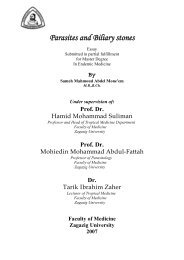Study of respiratory symptoms among sputum positive
Study of respiratory symptoms among sputum positive
Study of respiratory symptoms among sputum positive
You also want an ePaper? Increase the reach of your titles
YUMPU automatically turns print PDFs into web optimized ePapers that Google loves.
it<br />
fifuew oj"£iterature<br />
Diagnosis <strong>of</strong> pulmonary TB<br />
The diagnosis <strong>of</strong> pulmonary tuberculosis is not easy. Clinical signs<br />
are non specific and may be confused with many chest diseases.<br />
Radiological changes increase the suspicion <strong>of</strong> pulmonary tuberculosis.<br />
Examination <strong>of</strong> the <strong>sputum</strong> smear is helpful and has a high <strong>positive</strong><br />
predictive value (Gordin, 1990).<br />
• Chest radiograph in pulmonary TB<br />
The chest radiograph remains the most widely used and the most<br />
valuable tool in the diagnosis <strong>of</strong> pulmonary TB. Radiographic findings<br />
accurately reflect the pathologic process that occurs in the development <strong>of</strong><br />
primary and reactivation TB (try TB traditionally been a disease <strong>of</strong>infants<br />
and children) (Bloch et aI., 1989).<br />
In patients who have signs and <strong>symptoms</strong> suggesting pulmonary TB<br />
standard posterior-anterior and lateral radiograph <strong>of</strong> the chest should be<br />
obtained. Apical, lordotic or oblique views may aid in visualizing lesions<br />
obscured by bony structures and the heart. Bronchography may be useful in<br />
the definition <strong>of</strong> bronchial stenosis or bronchiactasis (Bass et aI., 1990).<br />
The traditional appearance <strong>of</strong>reactivation TB in the chest is a focal<br />
infiltrate and/or cavity in the apical or posterior segment <strong>of</strong>an upper lobe<br />
or perhaps in the superior segment <strong>of</strong>a lower lobe. While these traditional<br />
concepts <strong>of</strong> TB are still valid, a significant change in the pattern <strong>of</strong><br />
pulmonary TB has occurred in the past 30 years, with a much greater<br />
incidence <strong>of</strong> primary TB in adults. This change was first pointed out in<br />
1977, that noted a high incidence <strong>of</strong> nontraditional radiographic finding in<br />
adults with TB (Khan et aI., 1977). These non traditional findings reflected<br />
44
















